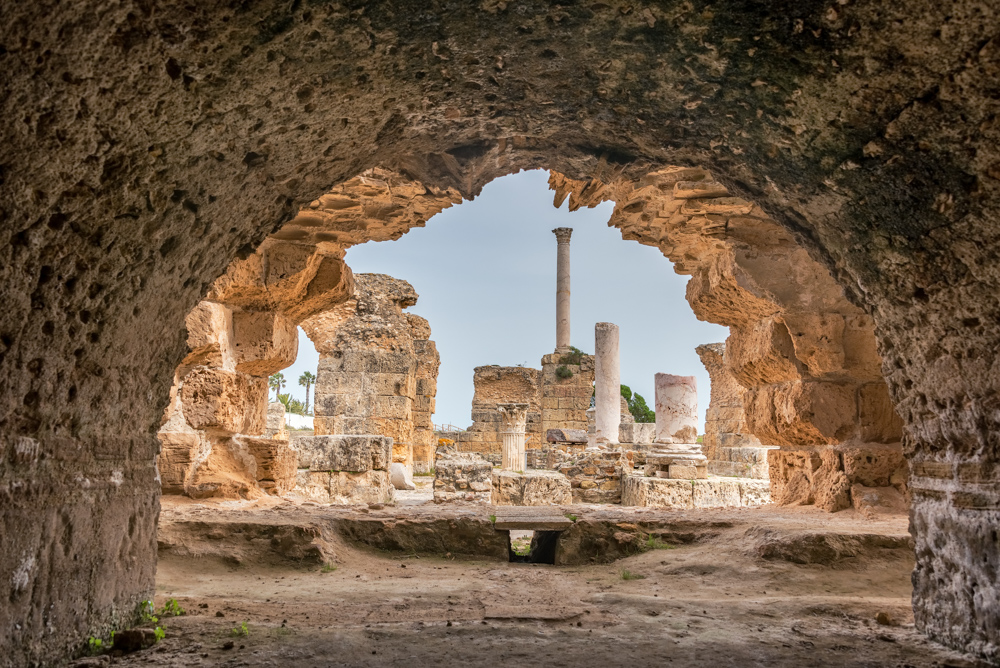Tunisia’s UNESCO World Heritage Sites are a treasure trove of cultural, historical, and natural heritage. From bustling walled cities to ancient ruins in idyllic scenery, Tunisia’s eight UNESCO sites offer a glimpse into the rich history and diverse culture of past civilizations.
In this blog post, we’ll give an overview of Tunisia’s UNESCO World Heritage sites and uncover what makes each one unique. As you read through this list, it’s easy to understand why Tunisia is so highly regarded as an incredible travel destination.
#1 – Carthage
Once the capital of a mighty empire that stretched across North Africa, Carthage eventually fell to Rome and became the most important city in Roman Africa. Today, its ruins cover multiple sites in a suburb outside of Tunis, providing visitors with a fascinating glimpse into both the Punic and Roman eras. From residential quarters to Christian basilicas, Roman baths, an amphitheatre, and more, the sites offer a rich tapestry of historical perspectives on one of the most important cities of the ancient world.
#2 – Tunis Medina
Capital of the Hafsid dynasty during the Middle Ages, today UNESCO counts some 700 monuments in the Tunis medina. With bustling marketplaces and ancient mosques around every corner, each part of the medina offers something unique, whether you’re looking for artisanal items or just wishing to absorb the atmosphere of one of North Africa’s oldest Arab settlements.
#3 – The Amphitheatre of El Jem
El Jem’s amphitheatre was one of the largest colosseums in the Roman Empire, and it remains remarkably well-preserved. The location of this colosseum is striking – it was built in a relatively small inland city, far from the capital Carthage. Visitors have nearly complete access to the site, allowing them to fully immerse themselves in its historical significance.
#4 – Dougga
Dougga offers visitors a glimpse into what life was like in the countryside during Roman times. The town is situated in North Africa’s most fertile valley once known as the breadbasket of the Roman Empire. With its well-preserved Roman theatre, temple, roads, and more, a visit to the site provides an experience that brings history to life.
#5 – Kairouan
Established in 670 AD as the first Islamic city in North Africa, Kairouan is the fourth holiest city in Islam. UNESCO designated Kairouan as World Heritage Centre in recognition of its numerous historical sites. The most grand and significant of these is the Great Mosque. UNESCO describes the Great Mosque as “an architectural masterpiece that served as a model for several other Maghreban mosques.” The charming medina (walled city), with its winding alleys and bustling markets, is another highlight of Kairouan.
#6 – Punic Town of Kerkouane and its Necropolis
Kerkouane is an essential site to visit for anyone seeking insight into life in Punic North Africa. The well-preserved foundations offer a surprisingly detailed perspective on life in this Punic city. Unlike other Punic historical sites, Kerkouane was not built upon by later Roman or Byzantine constructions. Visitors can also explore the nearby catacombs for further insight into Punic culture and history.
#7 – Sousse Medina
Established in 821 AD, the Sousse medina served as a signal city for the coastal defense system. The medina features a Ribat (citadel) and Grand Mosque located near the sea. For an authentic experience, venture off the main track to witness daily life in action. Locals shop for fresh produce and spices or to run errands at the small shops.
#8 – Ishkeul National Park
Lake Ishkeul is one of the last remaining stops for migratory birds on the North African coast. The population of ducks, flamingos, and other birds increases seasonally by the thousands as birds migrate across the Mediterranean. Ishkeul’s status as both a UNESCO World Heritage Centre and a Biosphere Reserve testifies to its significance in the past and present.
Conclusion
Tunisia’s UNESCO World Heritage Sites are as diverse as they are numerous. As you begin thinking about your Tunisia itinerary, you might consider which sites are of most interest to you. As mentioned in our article on the value of UNESCO for travelers, the sites can serve as an excellent starting point for planning your itinerary. By exploring these sites, you’ll gain a deeper appreciation for Tunisia’s unique identity and its place in the world.







